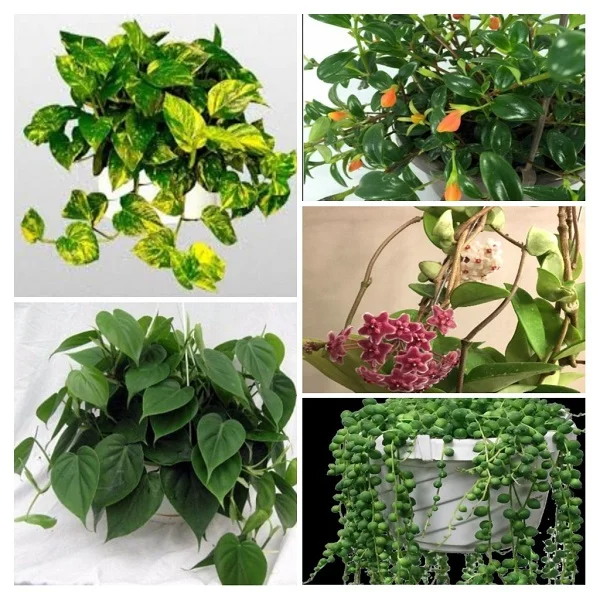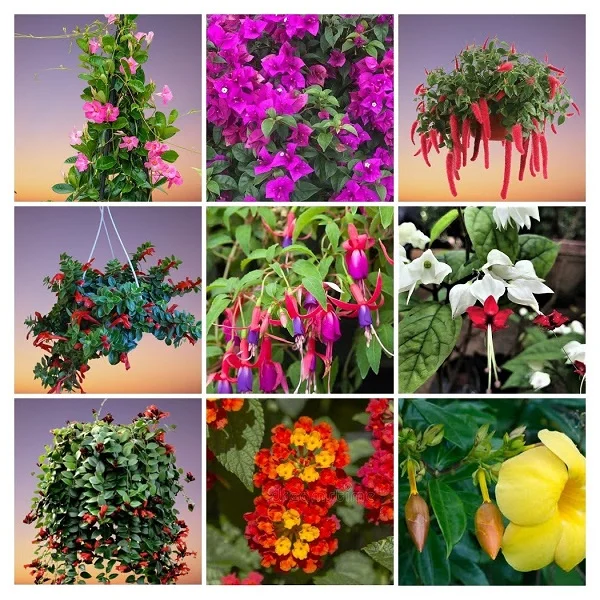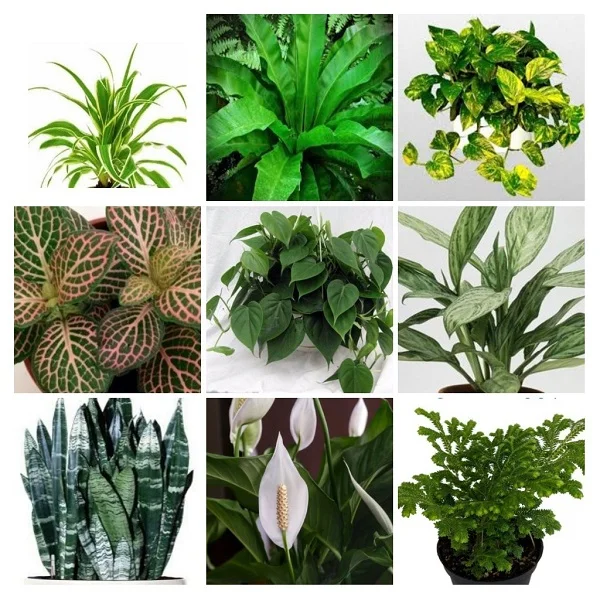Acalypha hispida (Chenille Plant) Care Indoors, Common Problems and Solutions
Last updated on
Some links in this post may be affiliate links
Acalypha hispida (Chenille Plant) grows best in bright indirect light, warm and humid conditions, and moderately moist, rich, well drained soil coupled with fortnightly feeding in the growing season.
Acalypha hispida also called Philippine Medusa, Red Hot Cat Tail, Monkey Tail or Foxtail is one of the popular flowering plants on account of its pendulous, brilliantly colored, furry flowers which are magnificient in a hanging basket or on a pedestal.
It bears large, bright-green, heart-shaped leaves with toothed margins on sparsely branched upright to arching stems.
Acalypha hispida has gained the Royal Horticultural Society's Award of Garden Merit because of its attractiveness and brilliantly colored, furry flowers.
Red Hot Cat Tail is a tropical perennial plant which cannot not tolerate cold temperatures. It is not cold hardy, therefore, it is best grown as an indoor plant in the cold temperate climates.
In climates with harsh winters, Monkey Tail can be grown outdoors as container plants during spring and summer which are brought inside when the temperatures drop to about 150C in fall.
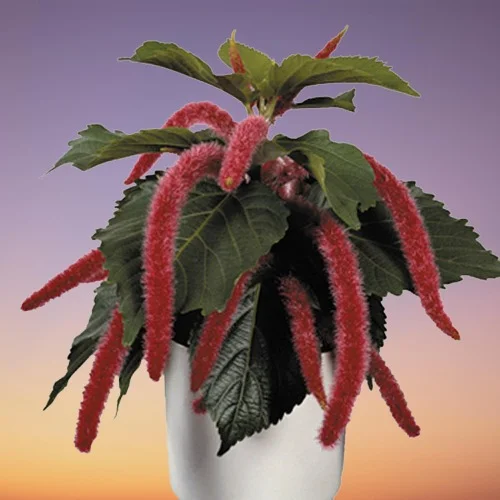
Botanical name: Acalypha hispida
Family: Euphorbiaceae
Common names: Chenille Plant, Philippine Medusa, Red Hot Cat Tail, Monkey Tail, Foxtail
Origin
Acalypha hispida is native to Malesia and Papuasia and has become naturalized to United States, Mexico, Nicaragua and Belize. The species name, 'hispida' is Latin for 'bristly', which refers to the pendant flowers which vaguely resemble brushes. The common name, 'Chenille' is French for Caterpillar.
How big do Chenille Plants get?
Chenille Plants can grow to a height of upto 5-8 feet which places these plants among the best flowering plants for indoor hanging baskets.
Flowers
Red Hot Cat Tail is dioecious, meaning male and female flowers are on different plants. The female flowers consist of a simple row of pistils covered in downy catkins and can grow up to 18 inches long. The male flowers are not showy, plants offered as ornamentals are all females.
Varieties
Apart from the basic Acalypha hispida with red inflorescence, other cultivars are available. They include a white cultivar, ‘Alba’, ‘White Margined’ with cream colored flowers and creamy white teeth on the leaf margins and a dwarf form, Acalypha pendula, which grows only 3-7 inches tall.
Related: Copperleaf Plant (Acalypha wilkesiana) Indoor Care and Common Issues
Is Acalypha hispida poisonous?
No. Acalypha hispida is non-toxic to humans and pets as outlined by ASPCA. Chenille Plants are safe for cats and dogs. They are safe to grow in the home.
How do you care for Acalypha hispida indoors?
To care for Acalypha hispida indoors, provide bright indirect light (filtered light), average warmth of 18-280C, humidity of 55-70%, and moderately moist, fertile, well drained soil coupled with fortnightly feeding in spring and summer.
Chenile Plant care requires regular pruning to control growth. Repotting is only needed when the plant becomes potbound. Keep reading for more on these growing conditions and how to achieve them.
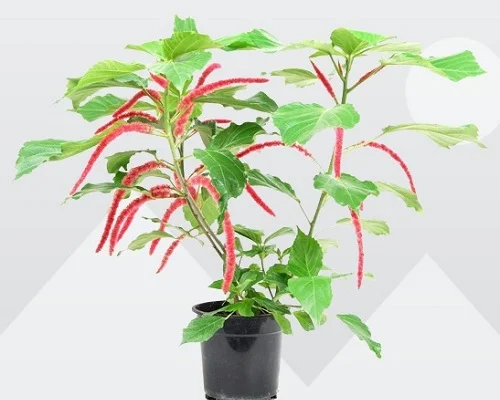
Watering
How often should you water a Chenile Plant?
Water Chenille Plant thoroughly in spring and summer when the top 2-3 inches of soil dry out. Keep the soil moderately moist and avoid overwatering to prevent rotting, yellowing and leaf loss.
Reduce watering in fall and winter as growth is minimal at this time to maintain the soil slightly moist. Do not allow the soil to dry out completely to prevent wilting, yellowing and leaf drop.
Use chlorine-free water like rain water or filtered water to prevent brown leaf edges and tips. Confirm that the water is at room temperature to avoid cold shock as it can result in stunted growth and leaf fall.
Ensure that the pot has a drainage hole and drain excess water from the catch plate or saucer to prevent waterlogging which can lead to root-rot and death of the plant.
Light Requirements
Does Acalypha hispida like sun or shade?
Acalypha hispida likes bright indirect light. A spot infront of a brightly-lit window is ideal for this plant. Keep it away from direct sunlight to prevent scorching; brown leaf marks.
Too little light will result in yellowing, leggy growth and lack of blooms. Where the natural light is not adequate, use a grow light to supplement it.
Regularly turn the pot to ensure the plant receives adequate light on all sides to promote even growth and prevent legginess.
You can move the Chenille Plant outdoors in spring and summer for some sun but acclimate it gradually to prevent scorching. Ensure to bring it back inside in fall when temperatures begin to drop, it can tolerate a temperature of 150C.
Temperature and Humidity
Chenille Plant prefers an average warmth of 18-280C. Keep it away from sources of drafts like windy doors, drafty windows, AC units, hot air vents and others to prevent temperature flactuations which may lead to reduced growth, yellowing and leaf drop.
Acalypha hispida flourishes in a humidity of 55-70%; too dry air may result in brown leaf tips and lack of blooms. Set the pot on a wet pebble tray, use a humidifier or group the plants together to elevate humidity for the plant. Ensure that there is good air circulation to prevent fungal infestations.
Fertilizer
What is the best fertilizer for Chenille Plants?
Feed Chenille Plant with a phosphorus-rich, water-soluble fertilizer every 2-3 weeks in spring and summer to boost blooming and healthy growth of the plant.
Withhold feeding in fall and winter to prevent fertilizer burn and death of the plant as growth is reduced at this time.
Flush out accumulated salts occasionally by running a stream of water through the soil. Allow the stream of water to run for some time and repeat the process several times.
Potting Soil
What kind of soil do Chenille Plants like?
The best soil for Chenille Plants should be well-draining, rich in organic matter and at a PH of 6-7.5 for the optimum growth of the plant. A blend of 2 parts of all purpose mix and 1 part perlite (for drainage) is good for the plant.
Repotting
Repot Chenille Plant at the beginning of spring, only when it is extremely pot-bound as it blooms best when slightly pot-bound. Do not repot a plant that is in flower as it can shorten the flowering period.
Select a pot 1 size larger than the current one that has a drainage hole to avoid getting soggy soil. Check out these pots with drainage holes on Amazon.
Fill the pot halfway with a well-draining soil to prevent waterlogging which can lead to root-rot and death of the plant.
Slip the plant out of its pot, shake off the old potting mix and trim the dead roots with clean and sterilized scissors.
Place the plant in the center of the new pot and refill with the free-draining soil.
Wet the soil thoroughly until water comes out through the drainage hole and discard the excess water from the saucer/
Position the plant infront of a brightly-lit window and continue with routine care.
Pruning & Grooming
How to prune a Chenille Plant
Pruning Chenille Plant involves"
- Removal of dead leaves and flowers to keep the plant neat and discourage pests and diseases.
- Cutting back the stems after flowering to about 12 inches above the soil to control growth and encourage a more bushy, compact growth. This will also boost blooming in the next season. Use a sharp, clean pair of pruning scissors.
Regularly clean the leaves with a soft brush to get rid of dust as well as discourage pest infestations.
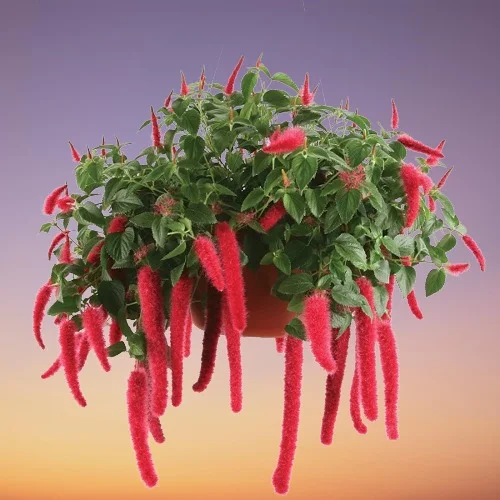
Chenille Plant Care Outdoors
Chenille Plants are tropical plants which require warm and humid conditions to thrive. They are not cold hardy, therefore, they are best grown as houseplants in the temperate climates.
However, in climates with harsh winters, they can be grown outdoors as container plants during spring and summer which are brought inside when the temperatures drop to about 150C in fall.
Cutback the plant to about 12 inches above the soil.
Place the plant in a warm, humid place where it can receive bright light.
Lessen watering to keep the soil slightly moist but do not let it dry out completely.
Do not feed the plant at this time as growth is reduced.
Ensure that there is good air circulation to prevent fungal infestations.
Once the temperatures warm up to 150C in spring, move the plant outdoors and place it in bright sunlight away from hot direct sunshine to prevent scorching.
Ensure that the soil remains moderately moist but not soggy by watering when the top 2-3 inches of soil feels dry.
Feed the plant every 2-3 weeks with a phosphorus-rich fertilizer to encourage blooming.
Acalypha hispida Propagation
How to propagate Acalypha hispida?
Acalypha hispida can be propagated from stem cuttings at the beginning of the growing season (spring to early summer) when in active growth. The stem cuttings can be rooted either in water or in soil.
Learn how to propagate Chenille Plant (Acalypha hispida) by 2 propagation methods.
How to grow Chenille Plant from seeds
- Fill a seed tray with well-draining soil and mist it lightly.
- Spread the seeds evenly on the moist soil and cover lightly with some soil.
- Cover the set up with a plastic sheet to create a greenhouse effect to hasten germination.
- Place the set up in a warm, brightly-lit place away from direct sunlight.
- Maintain the soil moist through out by light misting the soil surface until the seedlings are well established.
- When the seedlings have true leaves formed and are a reasonable size, transplant them into individual pots.
- Position the pots in a warm, well-lit spot away from direct sunlight.
- Keep the soil moist until the new plants are well established after which you can begin normal routine care.
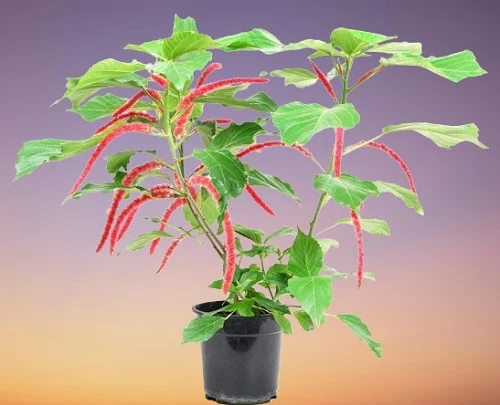
Chenille Plant Problems & Solutions
Chenille Plant problems are lack of blooms, yellow leaves, leaf drop, leggy growth, pests among others. Keep reading for more on these problems and how to solve them.
Lack of blooms
Why is my Chenille Plant not blooming?
Your Chenille Plant is not blooming due to nutrients deficiency, inconsistent watering, soggy soil, extreme temperatures or too little light.
How to fix it
Nutrients deficiency: Feed with a phosphorous-rich, water-soluble fertilizer every 2-3 weeks in spring and summer to encourage flowering.
Inconsistent watering: Water when the top 2-3 inches of soil dry out but do not allow it to dry out completely.
Soggy soil: Use a a pot that has a drainage hole and well-draining soil.
Extreme temperatures: Keep the plant away from draft sources like hot air vents, hot surfaces, AC units, windy doors and others.
Too little light: Move the plant to a brighter spot or instal a grow light if the natural lighting is not adequate.
Check out these 10 Reasons Why Chenille Plant is Not Blooming and How to Fix Them.
Plant dying
Why is my Chenille Plant dying?
Your Chenille Plant may be dying due to too little light, incorrect watering, soggy soil, temperature stress among others.
How to revive a Chenille Plant
Too little light: Move the plant to a brighter spot or instal a grow light if the natural light is not enough.
Incorrect watering: Do not water on a schedule. Water only when the top 2-3 inches of soil dry out.
Soggy soil: Use a pot with a drainage hole and a well-draining soil.
Temperature stress: Keep the plant away from sources of drafts like hot surfaces, hot air vents, AC units, windy doors among others.
Check out this post on 10 Reasons Why Chenille Plant is Dying and their Remedies.
Yellow leaves
Why are my Chenille Plant leaves turning yellow?
Your Chenille Plant leaves may turn yellow due to too little light, inconsistent watering, soggy soil, nutrient deficiency, temperature stress, direct sunlight and aging.
How to fix it
Too little light: Move the plant to a brighter spot or instal a grow light if the natural light is not enough.
Inconsistent watering: Do not water on a schedule. Water only when the top 2-3 inches of soil dry out.
Soggy soil: Use a well-draining soil and a pot with a drainage hole.
Nutrients deficiency: Apply a phosphorous-rich, water-soluble fertilizer every 2-3 weeks in spring and summer.
Temperature stress: Keep the plant away from drafts coming from hot surfaces, hot air vents, AC units, windy doors among others.
Direct sunlight: Move the plant to a more shaded spot or use a light curtain to shield it from the sunshine.
Aging: This is a natural process; as the plant matures the lower leaves turn yellow and fall off.
Read more on 12 Reasons Why Chenille Plant Leaves are Turning Yellow & Solutions.
Leaf drop
Leaf drop on Chenille Plant is caused by too little light, drafts, dry air, inconsistent watering or pest infestations.
How to fix it
Too little light: Move the plant to a brighter spot or use a grow light if the natural light is not enough.
Drafts: Keep it away from sources of drafts like AC units, drafty windows, hot air vents, windy doors and others.
Dry air: Set the pot on a wet pebble tray, use a humidifier or group the plants together to upscale humidity.
Inconsistent watering: Water when the top 2-3 inches of soil feel dry but do not allow the soil to dry out completely. Do not water on a schedule.
Pests infestations: Regularly check underneath the leaves for these pests and carry out timely control measures.
Leggy growth
Leggy growth on Chenille Plant is caused by too little light, nutrients deficiency or underwatering.
How t fix it
Too little light: Position the plant in a brighter spot or instal a grow light if the natural lighting is not adequate.
Nutrients deficiency: Feed the plant with a phosphorous-rich, liquid fertilizer every 2-3 weeks in spring and summer.
Underwatering: Maintain the soil moderately moist in spring and summer and slightly moist in fall and winter. Never allow the soil to dry out completely.
Pests
Common pests on Chenille Plant are mealybugs, whiteflies and spidermites which are prevalent in dry air conditions.
How to fix it
- Isolate the affected plant to prevent spread to the other plants.
- Treat the affected plant with neem oil or insecticidal soap as per the manufacturers instructions.
- Regularly check underneath and between the leaves for these pests and carry out timely control measures.
- Keep the plant well pruned and raise humidity to discourage the pests.
Frequently Asked Questions
1. How do you take care of Chenille Plant?
Caring for Chenille Plant entails giving it bright indirect light (dappled light), average warmth of 18-280C, humidity of 55-70% and moderately moist, well-drained soil that is rich in organic matter coupled with fortnightly feeding during the growing season.
2. Is Chenille Plant poisonous?
No. As indicated by ASPCA, Chenille Plant is non-toxic to both humans and pets. It is safe to grow in the home.
3. Can you propagate Chenille Plant in water?
Yes. Chenille Plant can be propagated at the beginning of the growing season from stem cuttings which can be rooted either in water or in soil.
4. How do you start a Chenille Plant?
Chenille Plant can be started from stem cuttings at the beginning of the growing season (spring to early summer). Propagating the plant at the beginning season allows adequate time for the growth and development of the new plant.
5. How to root Chenille Plant?
Chenille Plant stem cuttings can be rooted either in water or in soil. However, rooting in water may take a longer time than rooting in soil.
You liked it? Share on social media.
Related Content
Amazon Associates Disclosure
Homeplantsguide.com is a participant in the Amazon Services LLC Associates Program, an affiliate advertising program designed to provide a means for sites to earn advertising fees by advertising and linking to amazon.com.



